Effects of Irrigation Amount and Irrigation Frequency on Flue-Cured Tobacco Evapotranspiration and Water Use Efficiency Based on Three-Year Field Drip-Irrigated Experiments
Abstract
:1. Introduction
2. Materials and Methods
2.1. Experiment Site
2.2. Experimental Design
2.3. Tobacco Leaf Yield
2.4. Seasonal Evapotranspiration Calculation
2.5. Water Use Efficiency (CWUE) Calculation
2.6. Irrigation Water Use Efficiency (IWUE) Calculation
2.7. Statistical Analyses
3. Results
3.1. Weather Conditions in the Experimental Area
3.2. Effect of Irrigation Rate and Frequency on ETa
3.3. Effect of Irrigation Rate and Frequency on Flue-Cured Tobacco Yield
3.4. Relationship between Flue-Cured Tobacco Yield, Eta, and Irrigation Amount
3.5. The Relationship between IWUE and Irrigation Amount
3.6. The Relationship between CWUE and ETa
4. Summary and Conclusions
Author Contributions
Funding
Acknowledgments
Conflicts of Interest
References
- Li, V.C.; Tang, S. China’s New Road for Tobacco Control: Tobacco Crop Substitution. Am. J. Public Health 2018, 108, 1316–1317. [Google Scholar] [CrossRef] [PubMed]
- Piao, S.; Ciais, P.; Huang, Y.; Shen, Z.; Peng, S.; Li, J.; Zhou, L.; Liu, H.; Ma, Y.; Ding, Y. The impacts of climate change on water resources and agriculture in China. Nature 2010, 467, 43–51. [Google Scholar] [CrossRef] [PubMed]
- Liu, J.; Yang, W. Water sustainability for China and beyond. Science 2012, 337, 649–650. [Google Scholar] [CrossRef] [PubMed]
- Ayars, J.; Phene, C.; Hutmacher, R.; Davis, K.; Schoneman, R.; Vail, S.; Mead, R. Subsurface drip irrigation of row crops: A review of 15 years of research at the Water Management Research Laboratory. Agric. Water Manag. 1999, 42, 1–27. [Google Scholar] [CrossRef]
- Camp, C. Subsurface drip irrigation: A review. Trans. ASAE 1998, 41, 1353–1367. [Google Scholar] [CrossRef]
- Wang, Y.; Cai, H.; Zhang, X.; Yang, T. Progress in Strategy and Measure on Optimized Irrigation of Tobacco in China. Chin. Tob. Sci. 2007, 28, 6–9, 39. [Google Scholar] [CrossRef]
- Nilahyane, A.; Islam, M.A.; Mesbah, A.O.; Garcia y Garcia, A. Effect of Irrigation and Nitrogen Fertilization Strategies on Silage Corn Grown in Semi-Arid Conditions. Agronomy 2018, 8, 208. [Google Scholar] [CrossRef]
- Gago, J.; Douthe, C.; Florez-Sarasa, I.; Escalona, J.M.; Galmes, J.; Fernie, A.R.; Flexas, J.; Medrano, H. Opportunities for improving leaf water use efficiency under climate change conditions. Plant Sci. 2014, 226, 108–119. [Google Scholar] [CrossRef] [PubMed]
- Kang, S.; Zhang, L.; Liang, Y.; Dawes, W. Simulation of winter wheat yield and water use efficiency in the Loess Plateau of China using WAVES. Agric. Syst. 2003, 78, 355–367. [Google Scholar] [CrossRef]
- RoyChoudhury, A.; Roy, C.; Sengupta, D.N. Transgenic tobacco plants overexpressing the heterologous lea gene Rab16A from rice during high salt and water deficit display enhanced tolerance to salinity stress. Plant Cell Rep. 2007, 26, 1839–1859. [Google Scholar] [CrossRef] [PubMed]
- Chen, Y.; Marek, G.; Marek, T.; Brauer, D.; Srinivasan, R. Assessing the efficacy of the SWAT auto-irrigation function to simulate irrigation, evapotranspiration, and crop response to management strategies of the Texas High Plains. Water 2017, 9, 509. [Google Scholar] [CrossRef]
- Moore, J.M.; Sumner, P.E. Irrigating Tobacco; The University of Georgia: Athens, Georgia, 2010. [Google Scholar]
- Wang, F.-X.; Kang, Y.; Liu, S.-P. Effects of drip irrigation frequency on soil wetting pattern and potato growth in North. China Plain. Agric. Water Manag. 2006, 79, 248–264. [Google Scholar] [CrossRef]
- Xiang, Y.; Zou, H.; Zhang, F.; Qiang, S.; Wu, Y.; Yan, S.; Wang, H.; Wu, L.; Fan, J.; Wang, X. Effect of Irrigation Level and Irrigation Frequency on the Growth of Mini Chinese Cabbage and Residual Soil Nitrate Nitrogen. Sustainability 2019, 11, 111. [Google Scholar] [CrossRef]
- Hunsaker, D.; Clemmens, A.; Fangmeier, D. Cotton response to high frequency surface irrigation. Agric. Water Manag. 1998, 37, 55–74. [Google Scholar] [CrossRef]
- Cao, Q.; Wang, S.; Gao, L.; Ren, H.; Chen, Q.; Zhao, J.; Wang, Q.; Sui, X.; Zhang, Z. Effects of alternative furrow irrigation on growth and water use efficiency of cucumber in solar greenhouse. Trans. Chin. Soc. Agric. Eng. 2010, 26, 47–53. [Google Scholar]
- El-Hendawy, S.; Hokam, E.; Schmidhalter, U. Drip irrigation frequency: The effects and their interaction with nitrogen fertilization on sandy soil water distribution, maize yield and water use efficiency under Egyptian conditions. J. Agron. Crop Sci. 2008, 194, 180–192. [Google Scholar] [CrossRef]
- Zegada-Lizarazu, W.; Garcia-Apaza, E.; Ephrath, J.; Berliner, P. Above and below ground development of Acacia saligna shrubs grown under different irrigation frequencies in an arid environment. Plant Soil 2007, 297, 157–169. [Google Scholar] [CrossRef]
- Raviv, M.; Wallach, R.; Silber, A.; Medina, S.; Krasnovsky, A. The effect of hydraulic characteristics of volcanic materials on yield of roses grown in soilless culture. J. Am. Soc. Hortic. Sci. 1999, 124, 205–209. [Google Scholar] [CrossRef]
- Uçan, K.; Kıllı, F.; Gençoğlan, C.; Merdun, H. Effect of irrigation frequency and amount on water use efficiency and yield of sesame (Sesamum indicum L.) under field conditions. Field Crops Res. 2007, 101, 249–258. [Google Scholar]
- El-Hendawy, S.E.; Schmidhalter, U. Optimal coupling combinations between irrigation frequency and rate for drip-irrigated maize grown on sandy soil. Agric. Water Manag. 2010, 97, 439–448. [Google Scholar] [CrossRef]
- Howell, T.A. Enhancing water use efficiency in irrigated agriculture. Agron. J. 2001, 93, 281–289. [Google Scholar] [CrossRef]
- Anonymous. Meteorological Information Center of China. Available online: https://data.cma.cn (accessed on 9 September 2017).
- Hou, M.; Shao, X.; Li, Y. Effects of water and N-15-labelled fertilizer coupling on the growth, N uptake, quality and yield, of flue-cured tobaccos: A two-year lysimeter experiment. Res. Crop 2013, 14, 950–959. [Google Scholar]
- Douglas, E.; Beltrán-Przekurat, A.; Niyogi, D.; Pielke Sr, R.; Vörösmarty, C. The impact of agricultural intensification and irrigation on land–atmosphere interactions and Indian monsoon precipitation—A mesoscale modeling perspective. Glob. Planet. Chang. 2009, 67, 117–128. [Google Scholar] [CrossRef]
- DeAngelis, A.; Dominguez, F.; Fan, Y.; Robock, A.; Kustu, M.D.; Robinson, D. Evidence of enhanced precipitation due to irrigation over the Great Plains of the United States. J. Geophys. Res. Atmos. 2010. [Google Scholar] [CrossRef]
- Aka, A.; Servat, E.; Paturel, J.; Kouamé, B.; Lubès, H.; Masson, J. Analysis of the temporal variability of runoff in Ivory Coast.: Statistical approach and phenomena characterization. Hydrol. Sci. J. 1996, 41, 959–970. [Google Scholar] [CrossRef]
- Doorenbos, J.; Kassam, A. Yield Response to Water; Irrigation and Drainage Paper 33; FAO: Rome, Italy, 1979; p. 176. [Google Scholar]
- Payero, J.O.; Tarkalson, D.D.; Irmak, S.; Davison, D.; Petersen, J.L. Effect of irrigation amounts applied with subsurface drip irrigation on corn evapotranspiration, yield, water use efficiency, and dry matter production in a semiarid climate. Agric. Water Manag. 2008, 95, 895–908. [Google Scholar] [CrossRef] [Green Version]
- Djaman, K.; Neill, O.M.; Owen, C.; Smeal, D.; West, M.; Begay, D.; Allen, S.; Koudahe, K.; Irmak, S.; Lombard, K. Long-Term Winter Wheat (Triticum aestivum L.) Seasonal Irrigation Amount, Evapotranspiration, Yield, and Water Productivity under Semiarid Climate. Agronomy 2018, 8, 96. [Google Scholar] [CrossRef]
- Djaman, K.; Neill, O.M.; Owen, C.; Smeal, D.; Koudahe, K.; West, M.; Allen, S.; Lombard, K.; Irmak, S. Crop. Evapotranspiration, Irrigation Water Requirement and Water Productivity of Maize from Meteorological Data under Semiarid Climate. Agronomy 2018, 10, 405. [Google Scholar] [CrossRef]
- Elias, F.; María, A.S. Deficit irrigation for reducing agricultural water use. J. Exp. Bot. 2006, 58, 147–159. [Google Scholar] [Green Version]
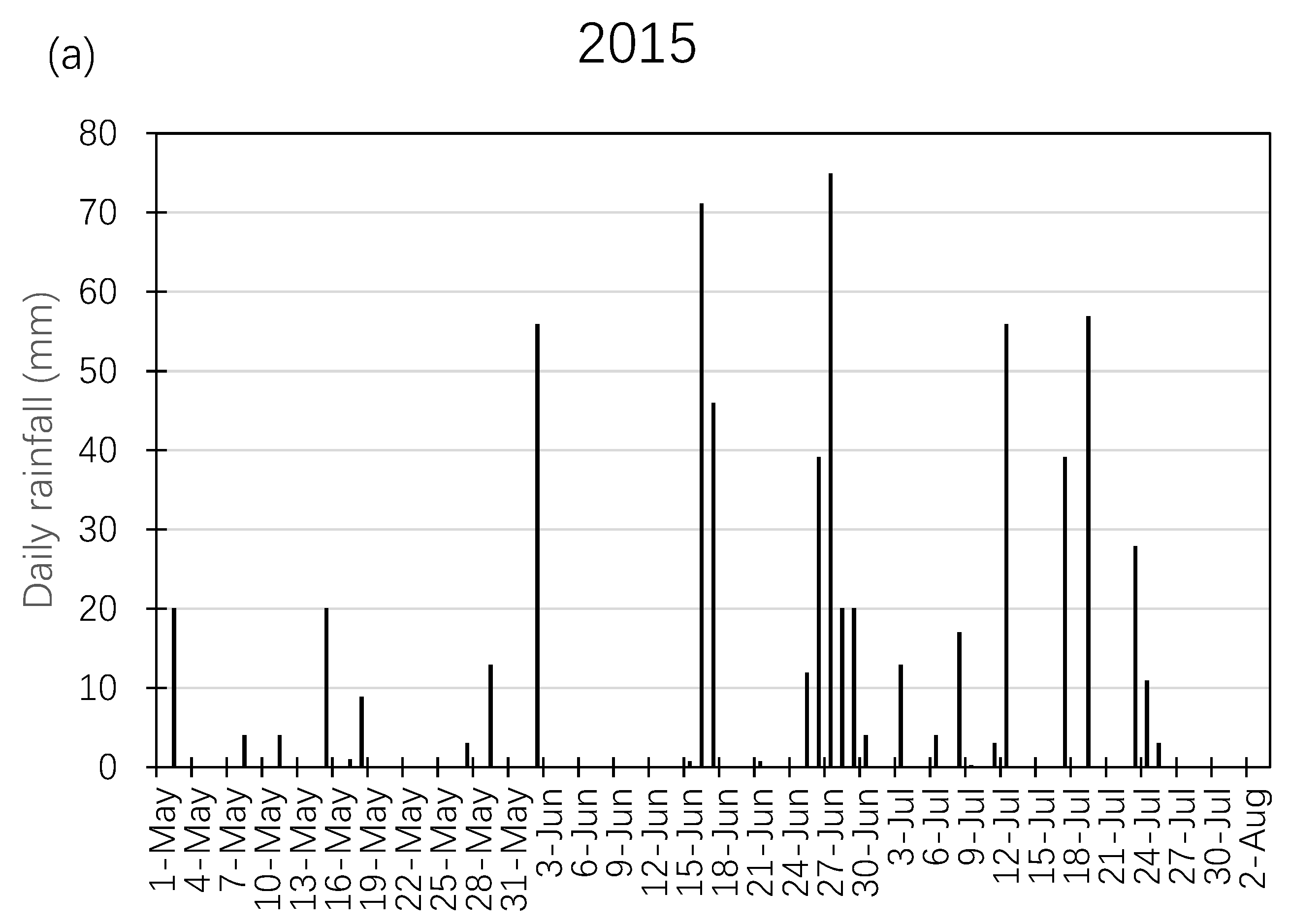
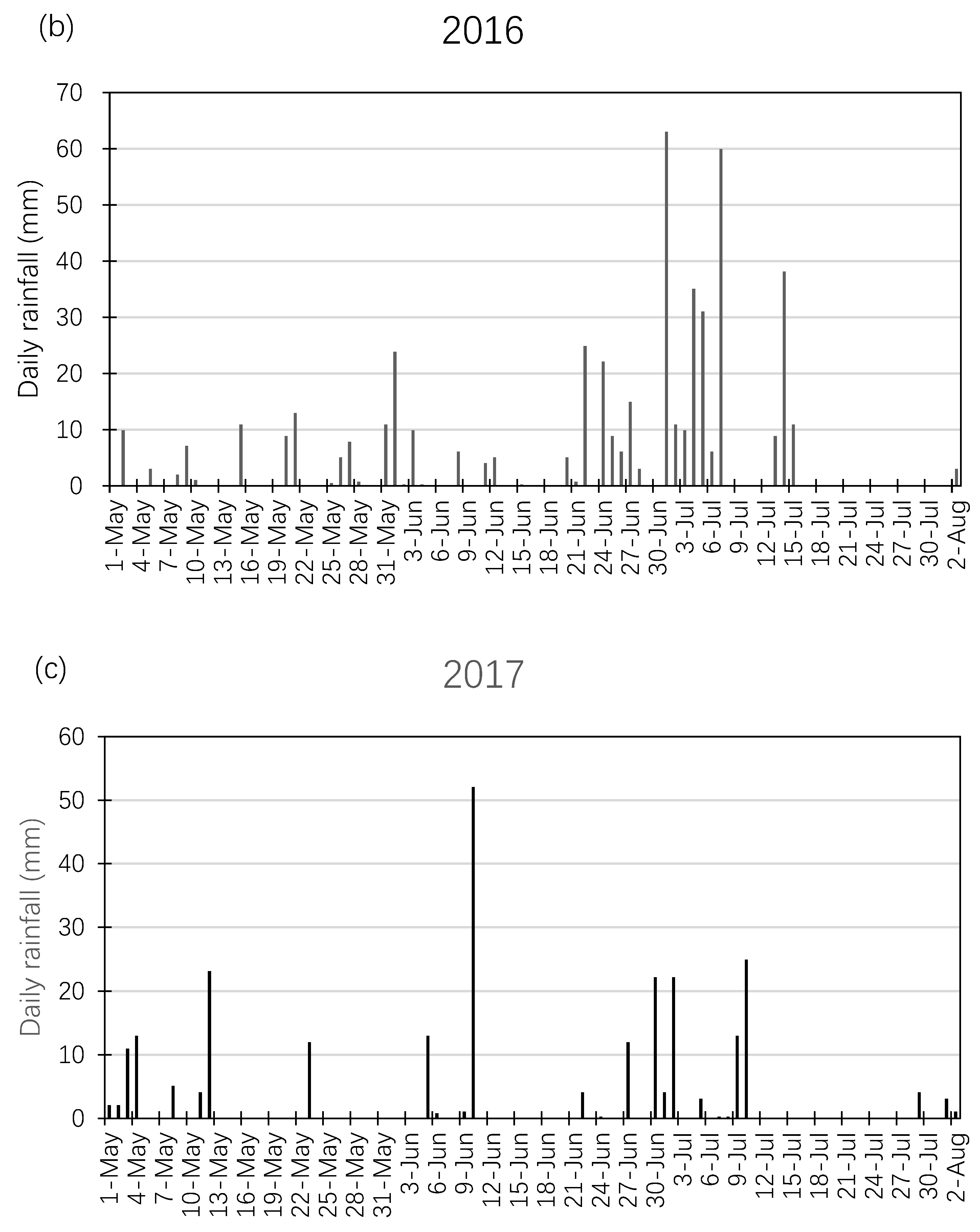
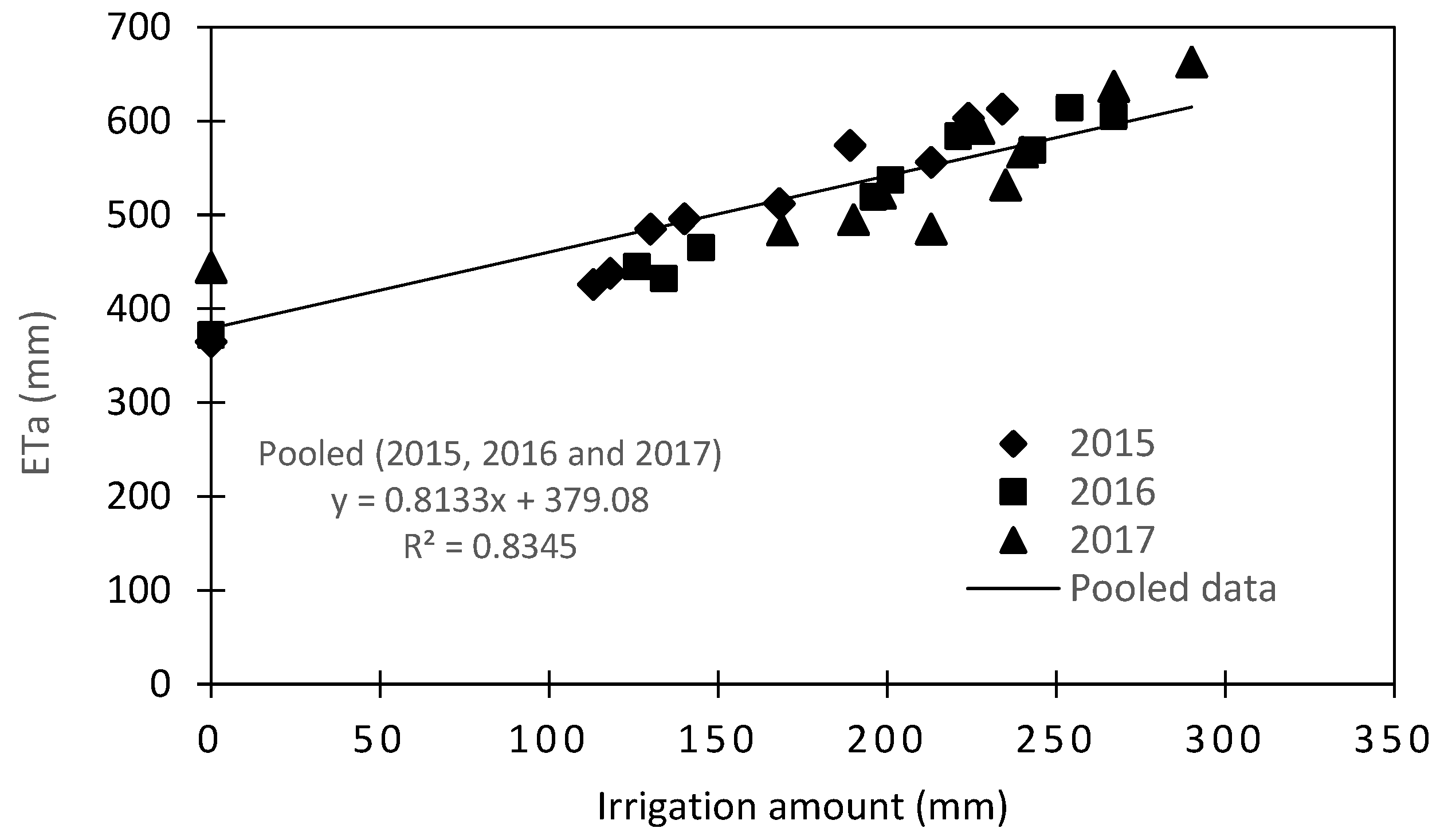
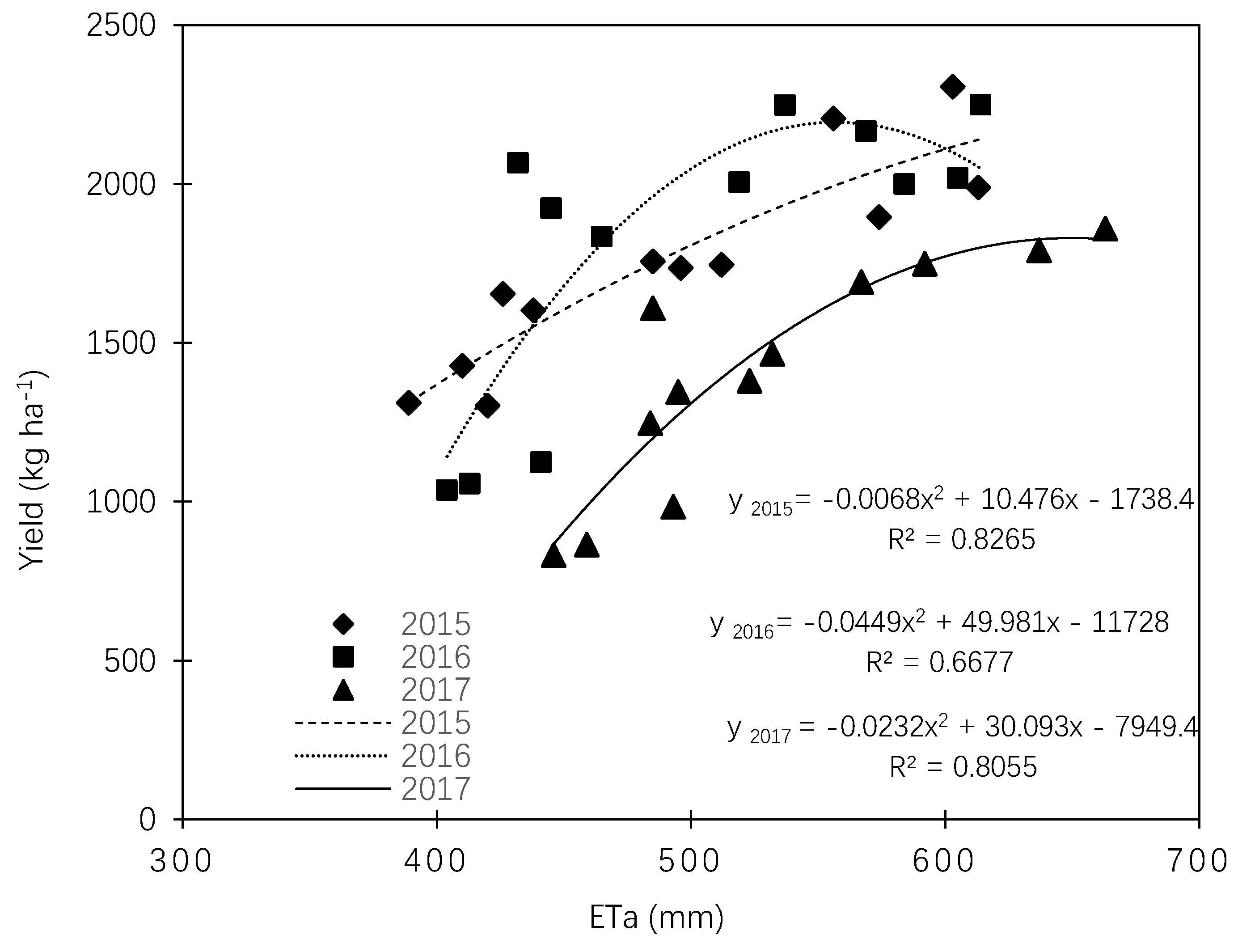
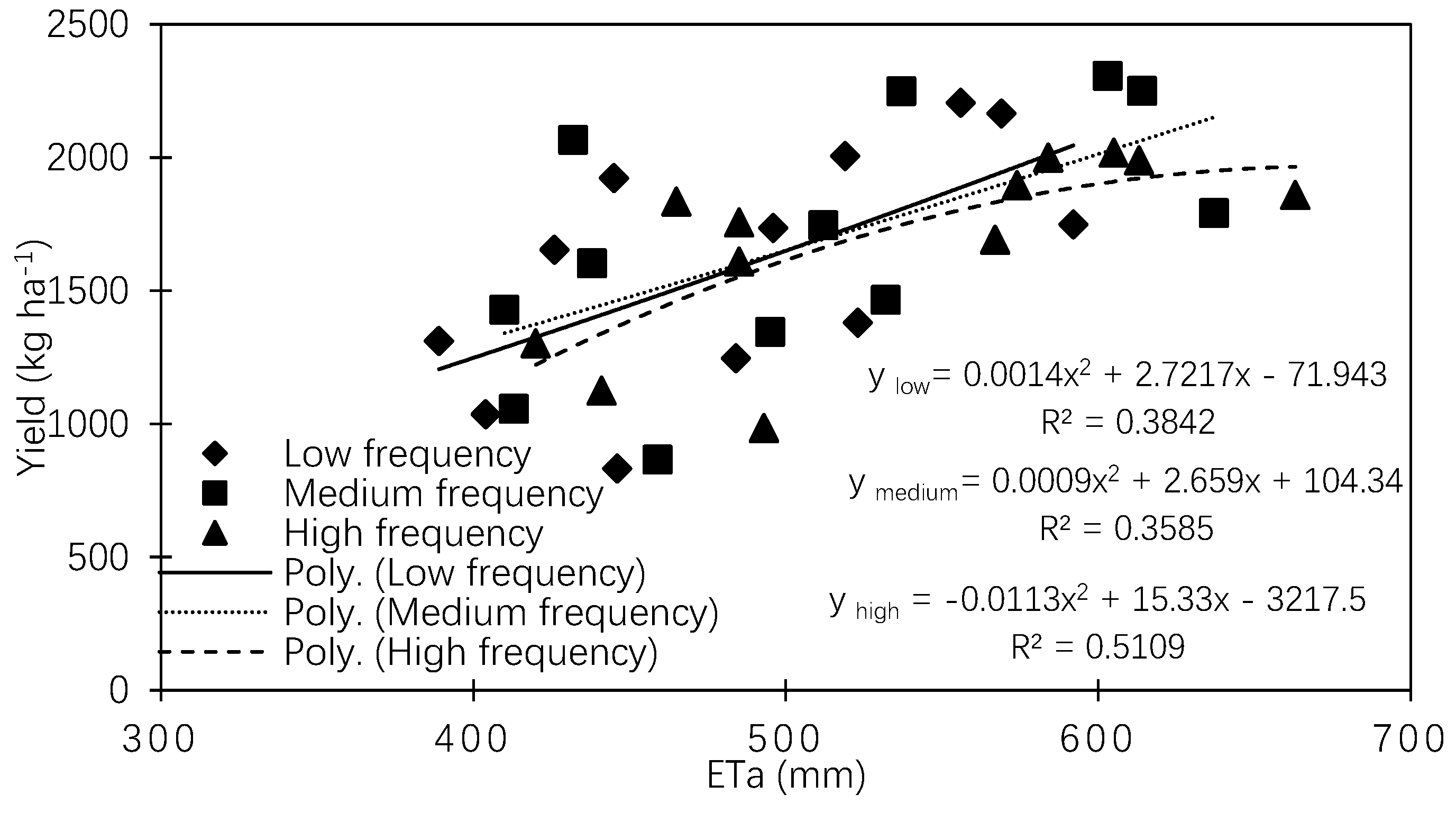
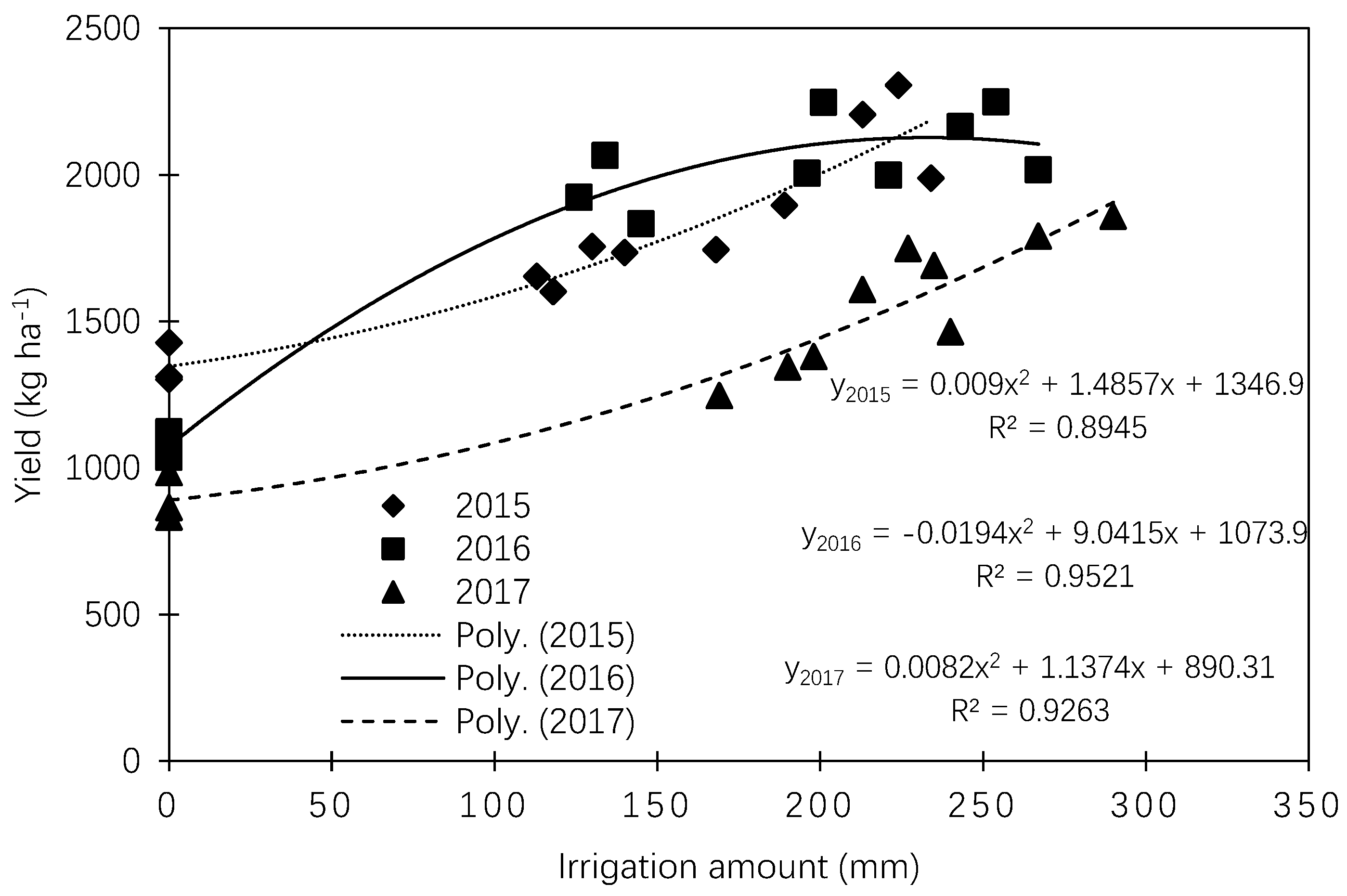
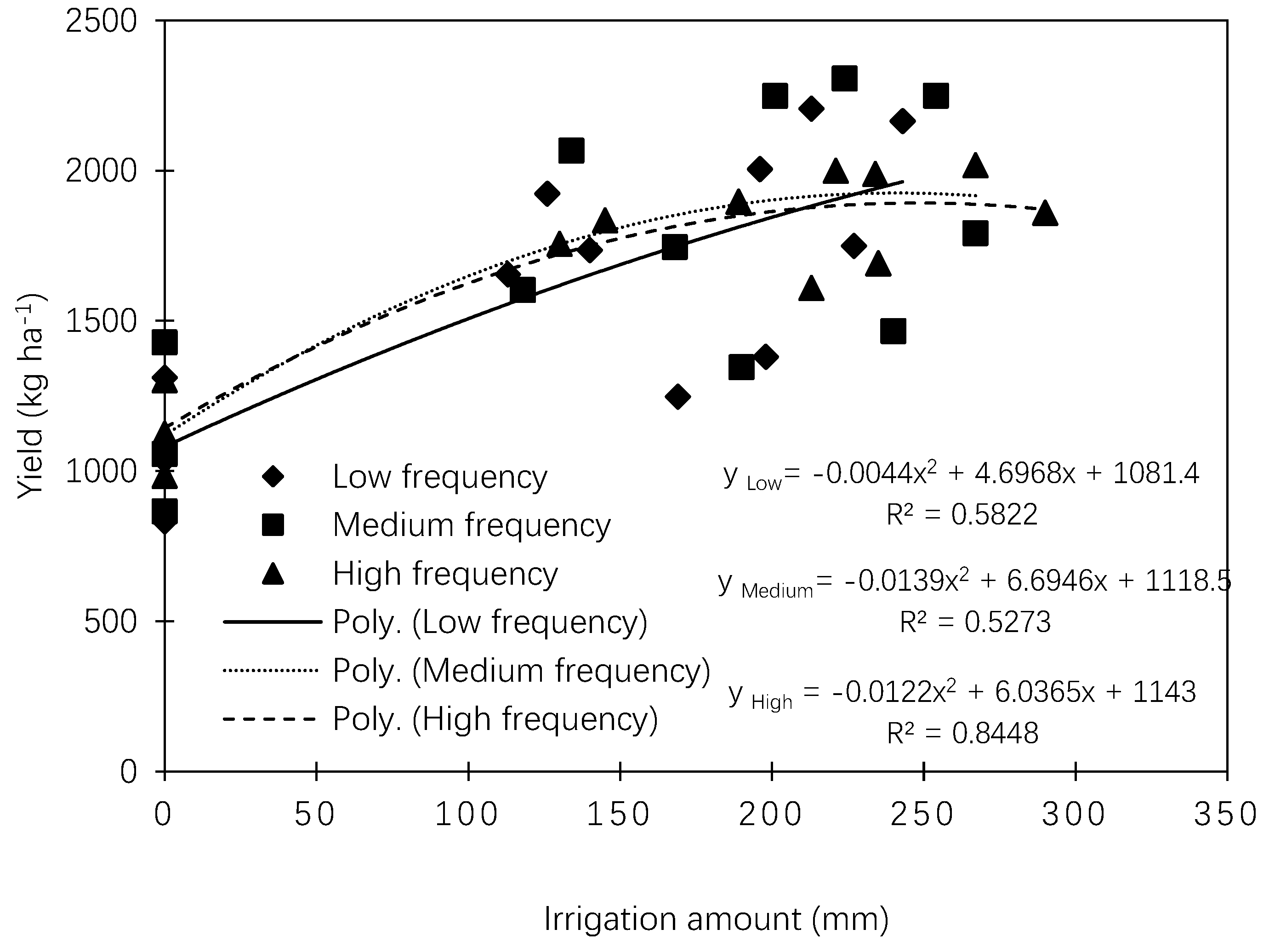


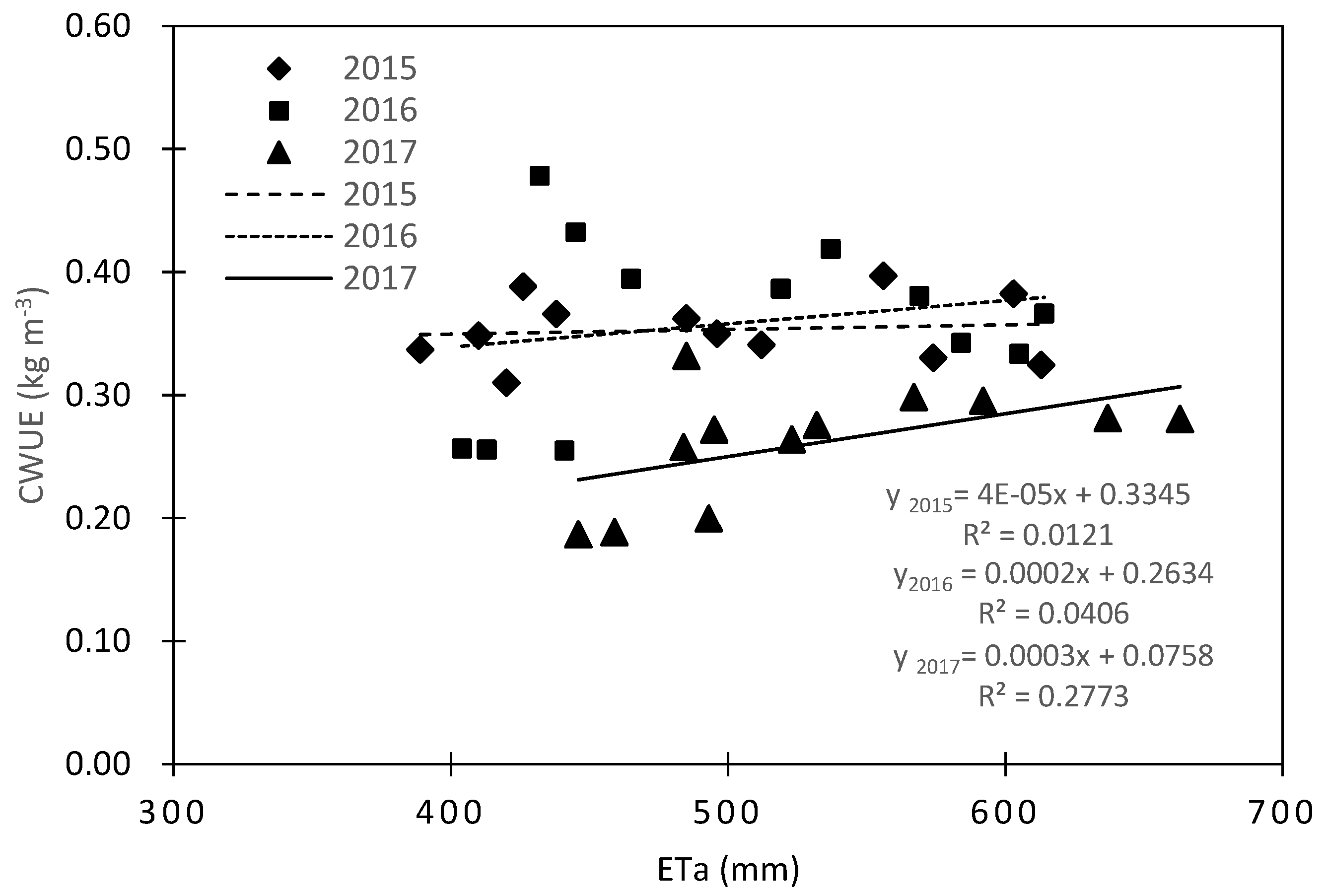
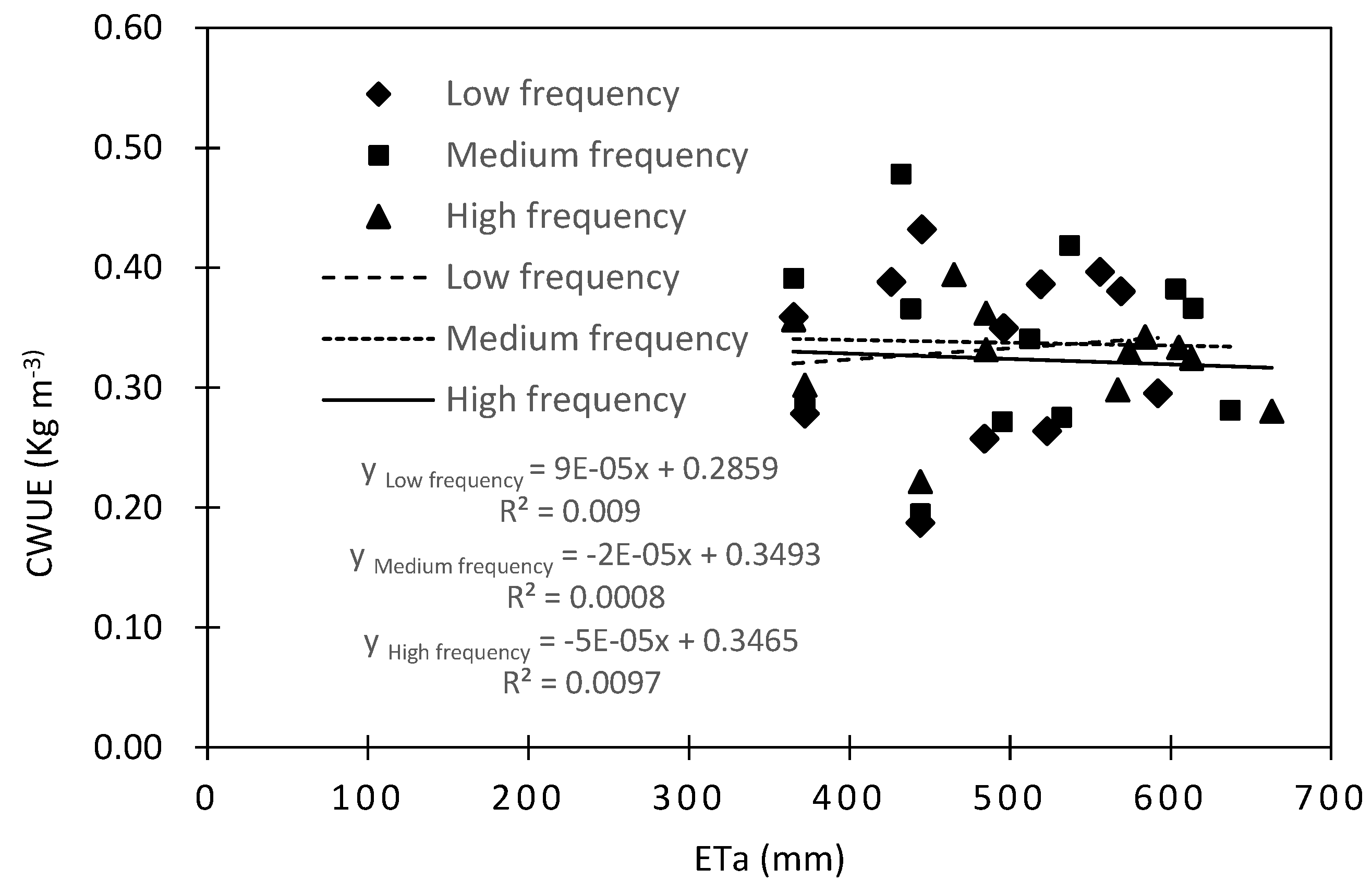

| Year | Field Capatity (%) | Bulk Density (g cm−3) | Total Nitrogen (g kg−1) | Total Phosphorus (g kg−1) | Organic Matter (g kg−1) | pH |
|---|---|---|---|---|---|---|
| 2015 | 21.2 | 1.32 | 1.31 | 0.36 | 19.19 | 6.98 |
| 2016 | 21.7 | 1.33 | 1.32 | 0.34 | 17.11 | 6.99 |
| 2017 | 20.4 | 1.33 | 1.32 | 0.35 | 18.03 | 6.70 |
| Management | 2015 | 2016 | 2017 |
|---|---|---|---|
| Transplanting date | 1 May 2015 | 2 May 2016 | 4 May 2017 |
| End of Harvest date | 2 Aug 2015 | 2 Aug 2016 | 2 Aug 2017 |
| Growth duration | 93 days | 92 days | 90 days |
| Hybrid | K326 | K326 | K326 |
| Pesticide applications | Type: Pyrethroid | ||
| Date: 30 days after planting and 45 days after planting | |||
| Bud emergence date under different irrigation frequencies | |||
| Low irrigation frequency | Date: 52 to 57 days after transplant | ||
| Medium irrigation frequency | Date: 57 to 63 days after transplant | ||
| High irrigation frequency | Date: 64 to 70 days after transplant | ||
| Irrigation Rate | 2015 | 2015 | 2015 | 2016 | 2016 | 2016 | 2017 | 2017 | 2017 |
|---|---|---|---|---|---|---|---|---|---|
| Low | Medium | High | Low | Medium | High | Low | Medium | High | |
| 100%IRT | 213 | 224 | 234 | 243 | 254 | 267 | 227 | 267 | 290 |
| 85%IRT | 140 | 168 | 189 | 196 | 201 | 221 | 198 | 235 | 240 |
| 70%IRT | 113 | 118 | 130 | 126 | 134 | 145 | 169 | 190 | 213 |
| RFT | 0 | 0 | 0 | 0 | 0 | 0 | 0 | 0 | 0 |
| Year | Month | Tmmax (°C) | Tmmin (°C) | RHmax (%) | RHmin (%) | Wsmax (m/s) | Wsmin (m/s) | Rainfall (mm) |
|---|---|---|---|---|---|---|---|---|
| 2015 | May | 26 | 17 | 100 | 14 | 22 | 0 | 74 |
| June | 28 | 21 | 100 | 19 | 22 | 0 | 345 | |
| July | 30 | 23 | 100 | 36 | 18 | 0 | 231 | |
| August | 32 | 24 | 100 | 33 | 20 | 0 | 133 | |
| 2016 | May | 24 | 16 | 100 | 13 | 32 | 0 | 81 |
| June | 28 | 20 | 100 | 28 | 26 | 0 | 136 | |
| July | 33 | 26 | 100 | 32 | 29 | 0 | 274 | |
| August | 34 | 25 | 100 | 17 | 35 | 0 | 73 | |
| 2017 | May | 28 | 18 | 100 | 16 | 32 | 0 | 72 |
| June | 29 | 21 | 100 | 22 | 29 | 0 | 105 | |
| July | 35 | 27 | 100 | 26 | 35 | 0 | 72 | |
| August | 32 | 25 | 100 | 30 | 35 | 0 | 148 |
| Eta | Low Frequency | Medium Frequency | High Frequency | ||||||
|---|---|---|---|---|---|---|---|---|---|
| 2015 | 2016 | 2017 | 2015 | 2016 | 2017 | 2015 | 2016 | 2017 | |
| 100%IRT | 556 | 569 | 592 | 603 | 614 | 637 | 613 | 605 | 663 |
| 85%IRT | 496 | 519 | 523 | 512 | 537 | 532 | 574 | 584 | 567 |
| 70%IRT | 426 | 445 | 484 | 438 | 432 | 495 | 485 | 465 | 485 |
| RFT | 365 | 372 | 444 | 365 | 372 | 444 | 365 | 372 | 444 |
| Irrigation | Low Frequency | Medium Frequency | High Frequency | ||||||
|---|---|---|---|---|---|---|---|---|---|
| Rate | 2015 | 2016 | 2017 | 2015 | 2016 | 2017 | 2015 | 2016 | 2017 |
| 100%IRT | 2206 | 2165 | 1749 | 2306 | 2249 | 1791 | 1989 | 2018 | 1859 |
| 85%IRT | 1735 | 2005 | 1380 | 1745 | 2248 | 1465 | 1896 | 1999 | 1691 |
| 70%IRT | 1654 | 1923 | 1247 | 1602 | 2066 | 1345 | 1756 | 1834 | 1609 |
| RFT | 1311 | 1036 | 832 | 1428 | 1056 | 865 | 1302 | 1124 | 984 |
© 2019 by the authors. Licensee MDPI, Basel, Switzerland. This article is an open access article distributed under the terms and conditions of the Creative Commons Attribution (CC BY) license (http://creativecommons.org/licenses/by/4.0/).
Share and Cite
Guang, J.; Shao, X.; Miao, Q.; Yang, X.; Gao, C.; Ding, F.; Yuan, Y. Effects of Irrigation Amount and Irrigation Frequency on Flue-Cured Tobacco Evapotranspiration and Water Use Efficiency Based on Three-Year Field Drip-Irrigated Experiments. Agronomy 2019, 9, 624. https://doi.org/10.3390/agronomy9100624
Guang J, Shao X, Miao Q, Yang X, Gao C, Ding F, Yuan Y. Effects of Irrigation Amount and Irrigation Frequency on Flue-Cured Tobacco Evapotranspiration and Water Use Efficiency Based on Three-Year Field Drip-Irrigated Experiments. Agronomy. 2019; 9(10):624. https://doi.org/10.3390/agronomy9100624
Chicago/Turabian StyleGuang, Jianfang, Xiaohou Shao, Qisong Miao, Xu Yang, Chao Gao, Fuzhang Ding, and Youbo Yuan. 2019. "Effects of Irrigation Amount and Irrigation Frequency on Flue-Cured Tobacco Evapotranspiration and Water Use Efficiency Based on Three-Year Field Drip-Irrigated Experiments" Agronomy 9, no. 10: 624. https://doi.org/10.3390/agronomy9100624





